Design of Liquid Level Controller System
VerifiedAdded on 2023/06/04
|14
|3499
|104
AI Summary
This research paper discusses the design of a liquid level controller system for commercial and small-scale purposes. It covers preliminary and detailed design, system functional analysis, synthesis and allocation of design criteria, system synthesis and allocation, system prototype, test and evaluation, production and construction, utilization and support, system test, validation and optimization process, and life cycle phases.
Contribute Materials
Your contribution can guide someone’s learning journey. Share your
documents today.
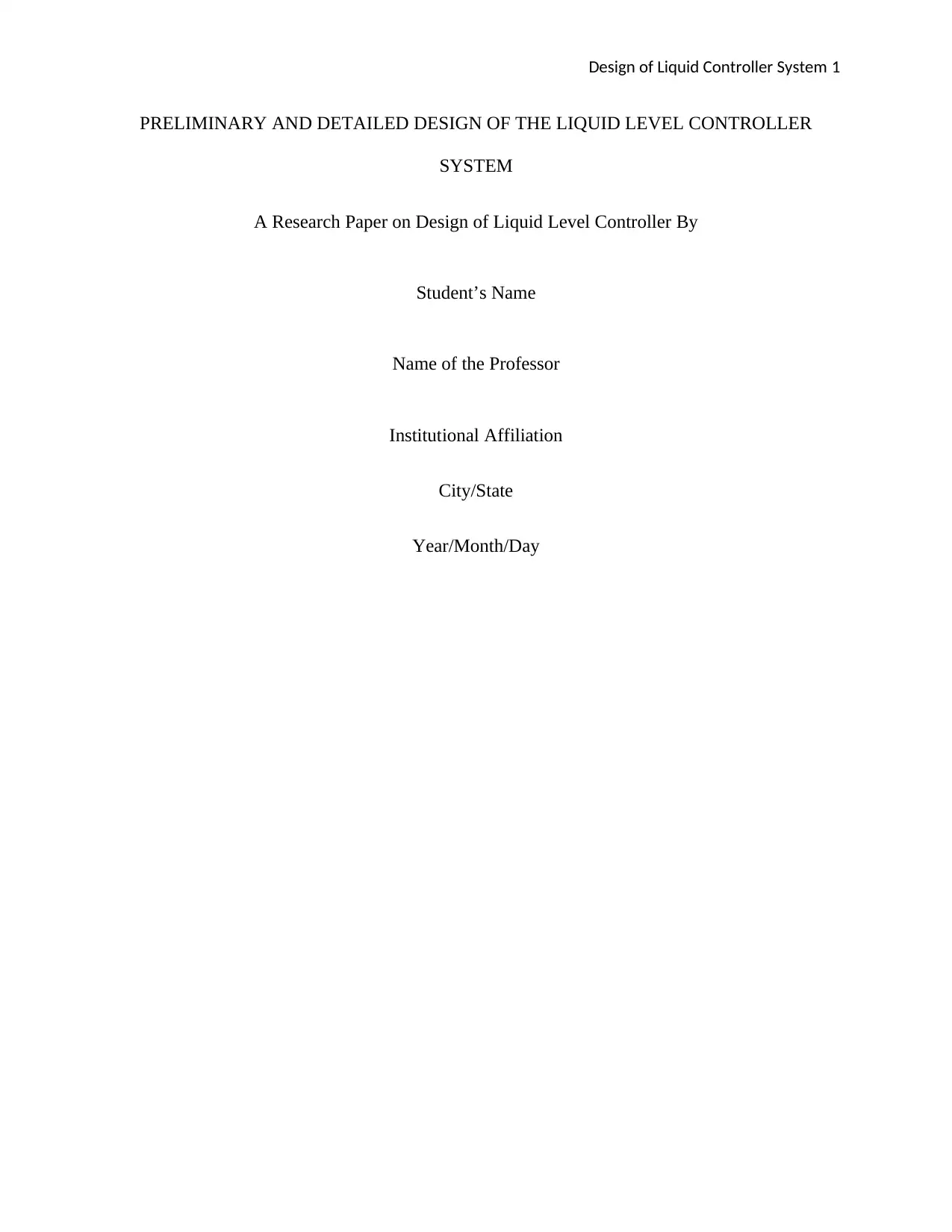
Design of Liquid Controller System 1
PRELIMINARY AND DETAILED DESIGN OF THE LIQUID LEVEL CONTROLLER
SYSTEM
A Research Paper on Design of Liquid Level Controller By
Student’s Name
Name of the Professor
Institutional Affiliation
City/State
Year/Month/Day
PRELIMINARY AND DETAILED DESIGN OF THE LIQUID LEVEL CONTROLLER
SYSTEM
A Research Paper on Design of Liquid Level Controller By
Student’s Name
Name of the Professor
Institutional Affiliation
City/State
Year/Month/Day
Secure Best Marks with AI Grader
Need help grading? Try our AI Grader for instant feedback on your assignments.
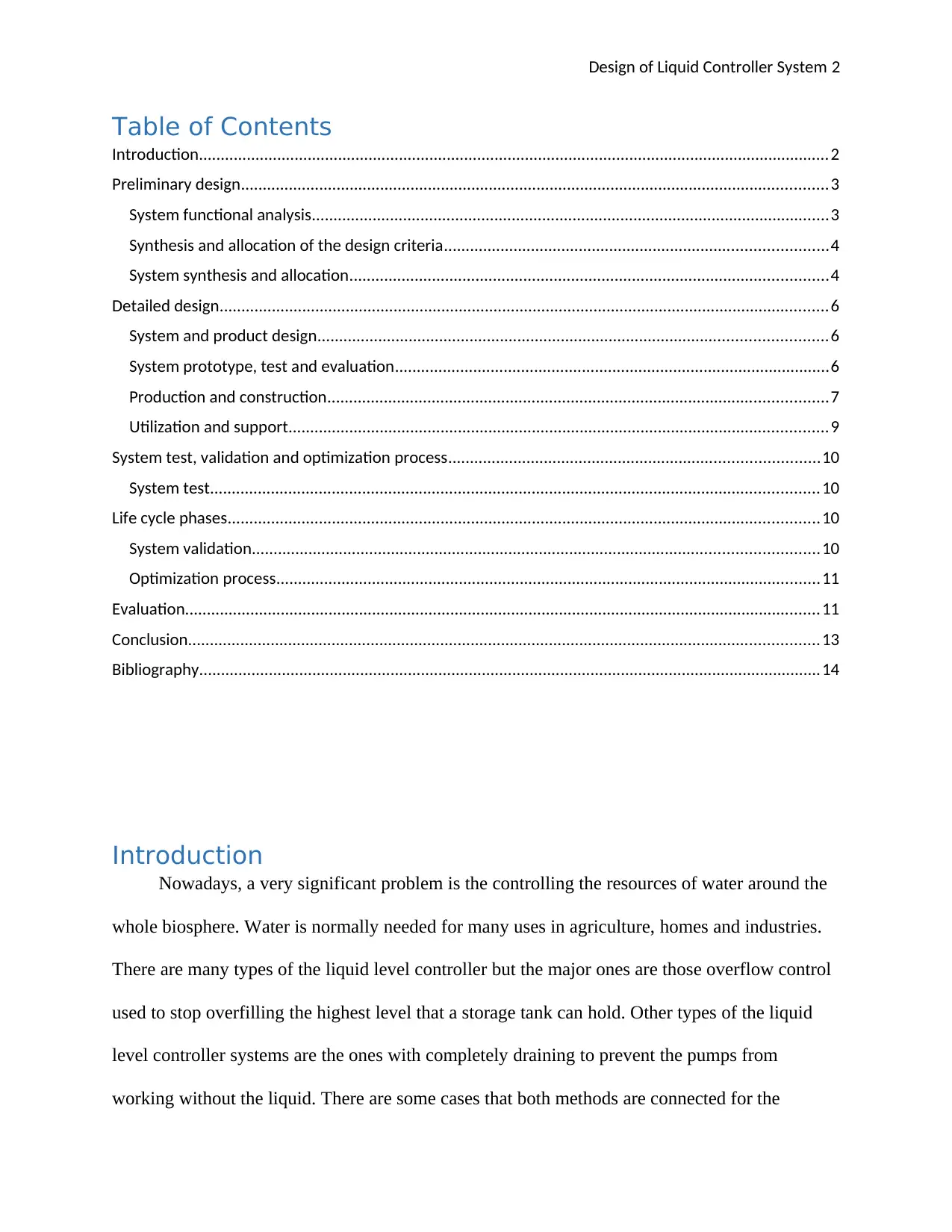
Design of Liquid Controller System 2
Table of Contents
Introduction.................................................................................................................................................2
Preliminary design.......................................................................................................................................3
System functional analysis.......................................................................................................................3
Synthesis and allocation of the design criteria........................................................................................4
System synthesis and allocation..............................................................................................................4
Detailed design............................................................................................................................................6
System and product design.....................................................................................................................6
System prototype, test and evaluation....................................................................................................6
Production and construction...................................................................................................................7
Utilization and support............................................................................................................................9
System test, validation and optimization process.....................................................................................10
System test............................................................................................................................................10
Life cycle phases........................................................................................................................................10
System validation..................................................................................................................................10
Optimization process.............................................................................................................................11
Evaluation..................................................................................................................................................11
Conclusion.................................................................................................................................................13
Bibliography...............................................................................................................................................14
Introduction
Nowadays, a very significant problem is the controlling the resources of water around the
whole biosphere. Water is normally needed for many uses in agriculture, homes and industries.
There are many types of the liquid level controller but the major ones are those overflow control
used to stop overfilling the highest level that a storage tank can hold. Other types of the liquid
level controller systems are the ones with completely draining to prevent the pumps from
working without the liquid. There are some cases that both methods are connected for the
Table of Contents
Introduction.................................................................................................................................................2
Preliminary design.......................................................................................................................................3
System functional analysis.......................................................................................................................3
Synthesis and allocation of the design criteria........................................................................................4
System synthesis and allocation..............................................................................................................4
Detailed design............................................................................................................................................6
System and product design.....................................................................................................................6
System prototype, test and evaluation....................................................................................................6
Production and construction...................................................................................................................7
Utilization and support............................................................................................................................9
System test, validation and optimization process.....................................................................................10
System test............................................................................................................................................10
Life cycle phases........................................................................................................................................10
System validation..................................................................................................................................10
Optimization process.............................................................................................................................11
Evaluation..................................................................................................................................................11
Conclusion.................................................................................................................................................13
Bibliography...............................................................................................................................................14
Introduction
Nowadays, a very significant problem is the controlling the resources of water around the
whole biosphere. Water is normally needed for many uses in agriculture, homes and industries.
There are many types of the liquid level controller but the major ones are those overflow control
used to stop overfilling the highest level that a storage tank can hold. Other types of the liquid
level controller systems are the ones with completely draining to prevent the pumps from
working without the liquid. There are some cases that both methods are connected for the
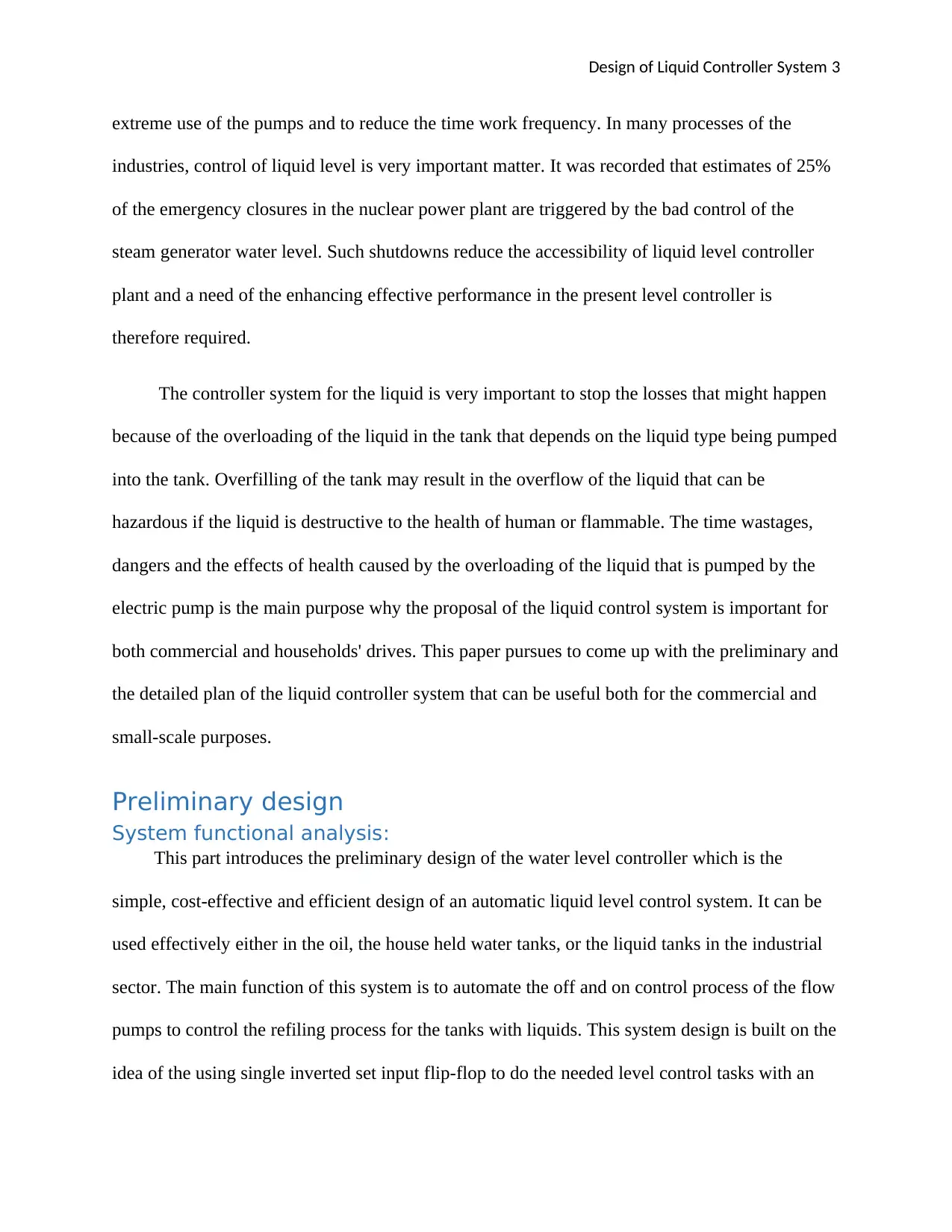
Design of Liquid Controller System 3
extreme use of the pumps and to reduce the time work frequency. In many processes of the
industries, control of liquid level is very important matter. It was recorded that estimates of 25%
of the emergency closures in the nuclear power plant are triggered by the bad control of the
steam generator water level. Such shutdowns reduce the accessibility of liquid level controller
plant and a need of the enhancing effective performance in the present level controller is
therefore required.
The controller system for the liquid is very important to stop the losses that might happen
because of the overloading of the liquid in the tank that depends on the liquid type being pumped
into the tank. Overfilling of the tank may result in the overflow of the liquid that can be
hazardous if the liquid is destructive to the health of human or flammable. The time wastages,
dangers and the effects of health caused by the overloading of the liquid that is pumped by the
electric pump is the main purpose why the proposal of the liquid control system is important for
both commercial and households' drives. This paper pursues to come up with the preliminary and
the detailed plan of the liquid controller system that can be useful both for the commercial and
small-scale purposes.
Preliminary design
System functional analysis:
This part introduces the preliminary design of the water level controller which is the
simple, cost-effective and efficient design of an automatic liquid level control system. It can be
used effectively either in the oil, the house held water tanks, or the liquid tanks in the industrial
sector. The main function of this system is to automate the off and on control process of the flow
pumps to control the refiling process for the tanks with liquids. This system design is built on the
idea of the using single inverted set input flip-flop to do the needed level control tasks with an
extreme use of the pumps and to reduce the time work frequency. In many processes of the
industries, control of liquid level is very important matter. It was recorded that estimates of 25%
of the emergency closures in the nuclear power plant are triggered by the bad control of the
steam generator water level. Such shutdowns reduce the accessibility of liquid level controller
plant and a need of the enhancing effective performance in the present level controller is
therefore required.
The controller system for the liquid is very important to stop the losses that might happen
because of the overloading of the liquid in the tank that depends on the liquid type being pumped
into the tank. Overfilling of the tank may result in the overflow of the liquid that can be
hazardous if the liquid is destructive to the health of human or flammable. The time wastages,
dangers and the effects of health caused by the overloading of the liquid that is pumped by the
electric pump is the main purpose why the proposal of the liquid control system is important for
both commercial and households' drives. This paper pursues to come up with the preliminary and
the detailed plan of the liquid controller system that can be useful both for the commercial and
small-scale purposes.
Preliminary design
System functional analysis:
This part introduces the preliminary design of the water level controller which is the
simple, cost-effective and efficient design of an automatic liquid level control system. It can be
used effectively either in the oil, the house held water tanks, or the liquid tanks in the industrial
sector. The main function of this system is to automate the off and on control process of the flow
pumps to control the refiling process for the tanks with liquids. This system design is built on the
idea of the using single inverted set input flip-flop to do the needed level control tasks with an
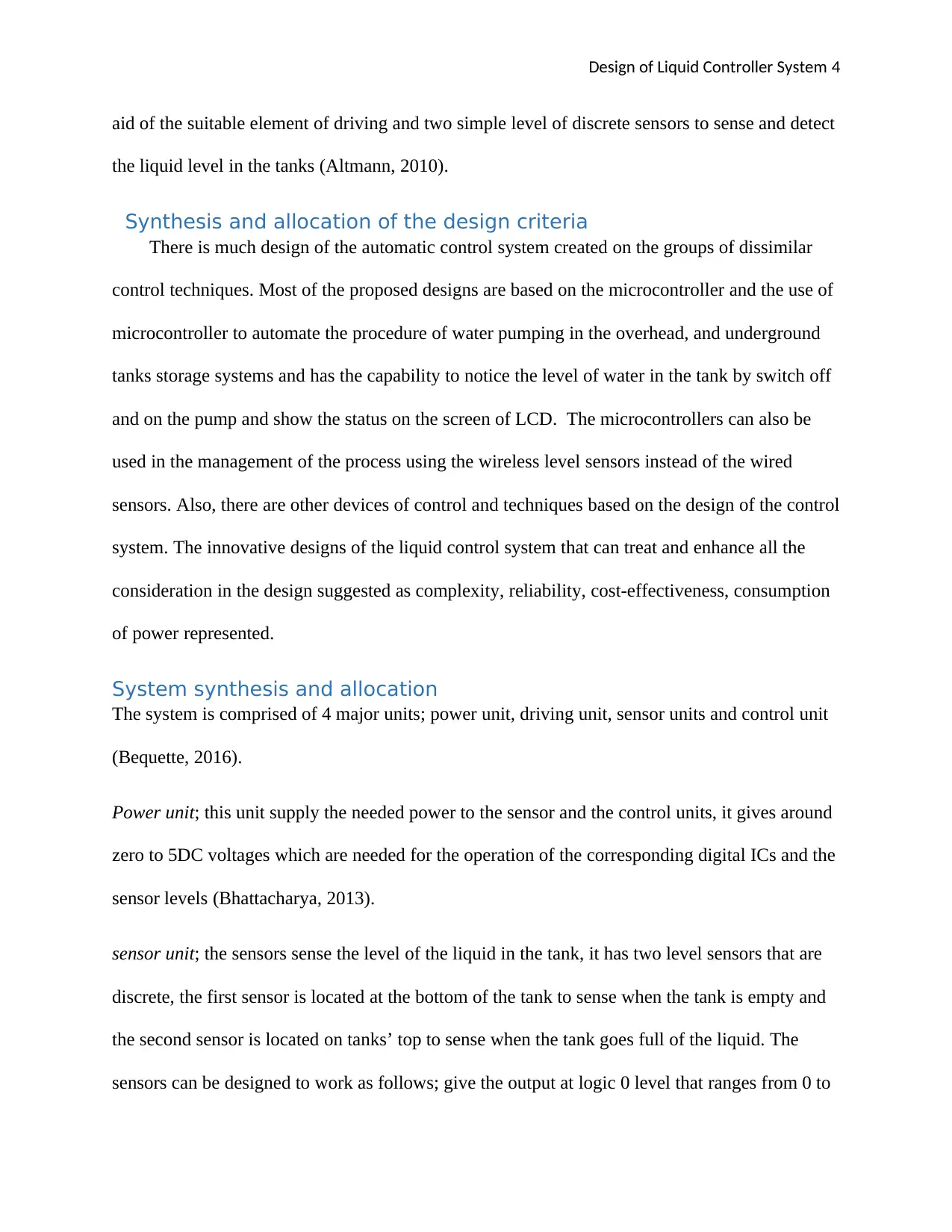
Design of Liquid Controller System 4
aid of the suitable element of driving and two simple level of discrete sensors to sense and detect
the liquid level in the tanks (Altmann, 2010).
Synthesis and allocation of the design criteria
There is much design of the automatic control system created on the groups of dissimilar
control techniques. Most of the proposed designs are based on the microcontroller and the use of
microcontroller to automate the procedure of water pumping in the overhead, and underground
tanks storage systems and has the capability to notice the level of water in the tank by switch off
and on the pump and show the status on the screen of LCD. The microcontrollers can also be
used in the management of the process using the wireless level sensors instead of the wired
sensors. Also, there are other devices of control and techniques based on the design of the control
system. The innovative designs of the liquid control system that can treat and enhance all the
consideration in the design suggested as complexity, reliability, cost-effectiveness, consumption
of power represented.
System synthesis and allocation
The system is comprised of 4 major units; power unit, driving unit, sensor units and control unit
(Bequette, 2016).
Power unit; this unit supply the needed power to the sensor and the control units, it gives around
zero to 5DC voltages which are needed for the operation of the corresponding digital ICs and the
sensor levels (Bhattacharya, 2013).
sensor unit; the sensors sense the level of the liquid in the tank, it has two level sensors that are
discrete, the first sensor is located at the bottom of the tank to sense when the tank is empty and
the second sensor is located on tanks’ top to sense when the tank goes full of the liquid. The
sensors can be designed to work as follows; give the output at logic 0 level that ranges from 0 to
aid of the suitable element of driving and two simple level of discrete sensors to sense and detect
the liquid level in the tanks (Altmann, 2010).
Synthesis and allocation of the design criteria
There is much design of the automatic control system created on the groups of dissimilar
control techniques. Most of the proposed designs are based on the microcontroller and the use of
microcontroller to automate the procedure of water pumping in the overhead, and underground
tanks storage systems and has the capability to notice the level of water in the tank by switch off
and on the pump and show the status on the screen of LCD. The microcontrollers can also be
used in the management of the process using the wireless level sensors instead of the wired
sensors. Also, there are other devices of control and techniques based on the design of the control
system. The innovative designs of the liquid control system that can treat and enhance all the
consideration in the design suggested as complexity, reliability, cost-effectiveness, consumption
of power represented.
System synthesis and allocation
The system is comprised of 4 major units; power unit, driving unit, sensor units and control unit
(Bequette, 2016).
Power unit; this unit supply the needed power to the sensor and the control units, it gives around
zero to 5DC voltages which are needed for the operation of the corresponding digital ICs and the
sensor levels (Bhattacharya, 2013).
sensor unit; the sensors sense the level of the liquid in the tank, it has two level sensors that are
discrete, the first sensor is located at the bottom of the tank to sense when the tank is empty and
the second sensor is located on tanks’ top to sense when the tank goes full of the liquid. The
sensors can be designed to work as follows; give the output at logic 0 level that ranges from 0 to
Secure Best Marks with AI Grader
Need help grading? Try our AI Grader for instant feedback on your assignments.
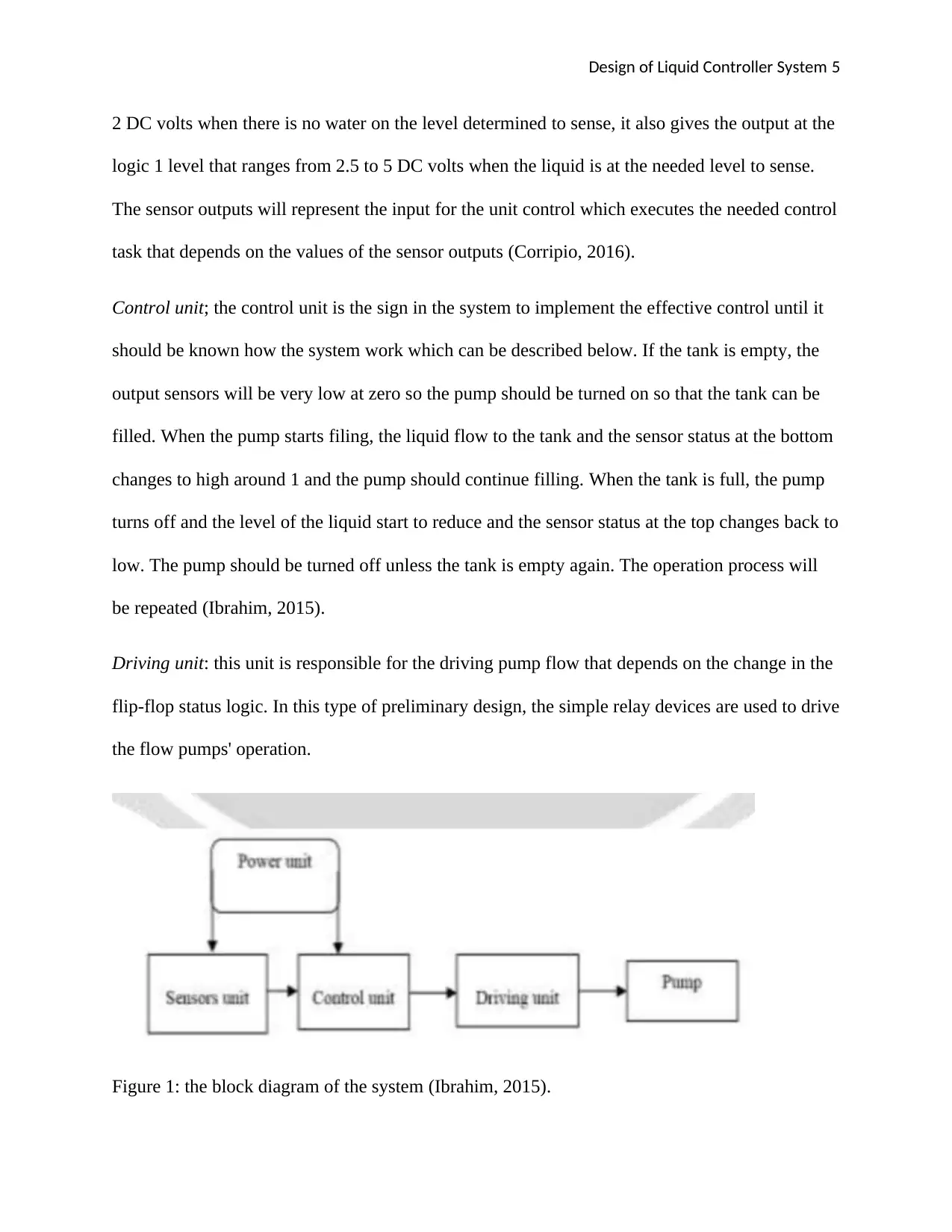
Design of Liquid Controller System 5
2 DC volts when there is no water on the level determined to sense, it also gives the output at the
logic 1 level that ranges from 2.5 to 5 DC volts when the liquid is at the needed level to sense.
The sensor outputs will represent the input for the unit control which executes the needed control
task that depends on the values of the sensor outputs (Corripio, 2016).
Control unit; the control unit is the sign in the system to implement the effective control until it
should be known how the system work which can be described below. If the tank is empty, the
output sensors will be very low at zero so the pump should be turned on so that the tank can be
filled. When the pump starts filing, the liquid flow to the tank and the sensor status at the bottom
changes to high around 1 and the pump should continue filling. When the tank is full, the pump
turns off and the level of the liquid start to reduce and the sensor status at the top changes back to
low. The pump should be turned off unless the tank is empty again. The operation process will
be repeated (Ibrahim, 2015).
Driving unit: this unit is responsible for the driving pump flow that depends on the change in the
flip-flop status logic. In this type of preliminary design, the simple relay devices are used to drive
the flow pumps' operation.
Figure 1: the block diagram of the system (Ibrahim, 2015).
2 DC volts when there is no water on the level determined to sense, it also gives the output at the
logic 1 level that ranges from 2.5 to 5 DC volts when the liquid is at the needed level to sense.
The sensor outputs will represent the input for the unit control which executes the needed control
task that depends on the values of the sensor outputs (Corripio, 2016).
Control unit; the control unit is the sign in the system to implement the effective control until it
should be known how the system work which can be described below. If the tank is empty, the
output sensors will be very low at zero so the pump should be turned on so that the tank can be
filled. When the pump starts filing, the liquid flow to the tank and the sensor status at the bottom
changes to high around 1 and the pump should continue filling. When the tank is full, the pump
turns off and the level of the liquid start to reduce and the sensor status at the top changes back to
low. The pump should be turned off unless the tank is empty again. The operation process will
be repeated (Ibrahim, 2015).
Driving unit: this unit is responsible for the driving pump flow that depends on the change in the
flip-flop status logic. In this type of preliminary design, the simple relay devices are used to drive
the flow pumps' operation.
Figure 1: the block diagram of the system (Ibrahim, 2015).
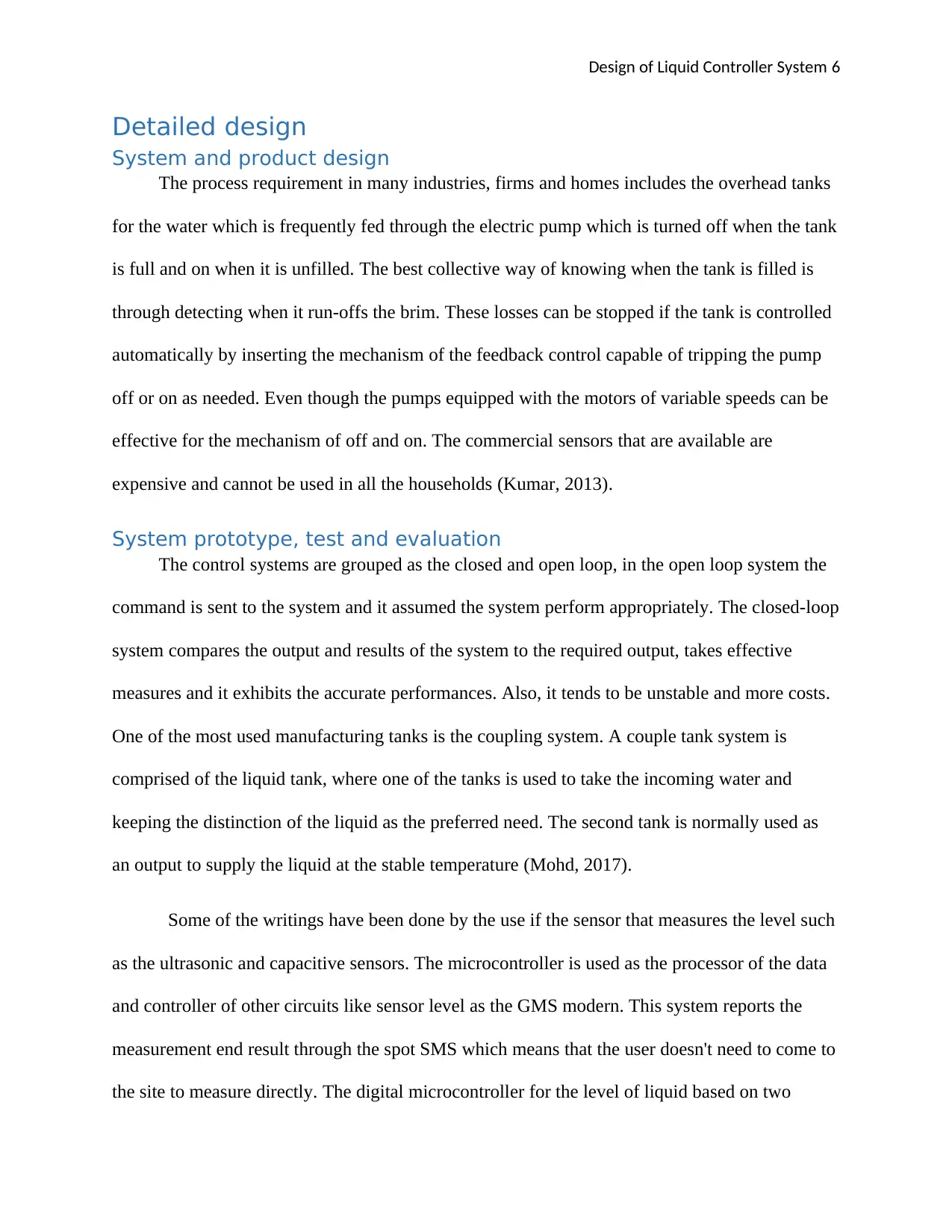
Design of Liquid Controller System 6
Detailed design
System and product design
The process requirement in many industries, firms and homes includes the overhead tanks
for the water which is frequently fed through the electric pump which is turned off when the tank
is full and on when it is unfilled. The best collective way of knowing when the tank is filled is
through detecting when it run-offs the brim. These losses can be stopped if the tank is controlled
automatically by inserting the mechanism of the feedback control capable of tripping the pump
off or on as needed. Even though the pumps equipped with the motors of variable speeds can be
effective for the mechanism of off and on. The commercial sensors that are available are
expensive and cannot be used in all the households (Kumar, 2013).
System prototype, test and evaluation
The control systems are grouped as the closed and open loop, in the open loop system the
command is sent to the system and it assumed the system perform appropriately. The closed-loop
system compares the output and results of the system to the required output, takes effective
measures and it exhibits the accurate performances. Also, it tends to be unstable and more costs.
One of the most used manufacturing tanks is the coupling system. A couple tank system is
comprised of the liquid tank, where one of the tanks is used to take the incoming water and
keeping the distinction of the liquid as the preferred need. The second tank is normally used as
an output to supply the liquid at the stable temperature (Mohd, 2017).
Some of the writings have been done by the use if the sensor that measures the level such
as the ultrasonic and capacitive sensors. The microcontroller is used as the processor of the data
and controller of other circuits like sensor level as the GMS modern. This system reports the
measurement end result through the spot SMS which means that the user doesn't need to come to
the site to measure directly. The digital microcontroller for the level of liquid based on two
Detailed design
System and product design
The process requirement in many industries, firms and homes includes the overhead tanks
for the water which is frequently fed through the electric pump which is turned off when the tank
is full and on when it is unfilled. The best collective way of knowing when the tank is filled is
through detecting when it run-offs the brim. These losses can be stopped if the tank is controlled
automatically by inserting the mechanism of the feedback control capable of tripping the pump
off or on as needed. Even though the pumps equipped with the motors of variable speeds can be
effective for the mechanism of off and on. The commercial sensors that are available are
expensive and cannot be used in all the households (Kumar, 2013).
System prototype, test and evaluation
The control systems are grouped as the closed and open loop, in the open loop system the
command is sent to the system and it assumed the system perform appropriately. The closed-loop
system compares the output and results of the system to the required output, takes effective
measures and it exhibits the accurate performances. Also, it tends to be unstable and more costs.
One of the most used manufacturing tanks is the coupling system. A couple tank system is
comprised of the liquid tank, where one of the tanks is used to take the incoming water and
keeping the distinction of the liquid as the preferred need. The second tank is normally used as
an output to supply the liquid at the stable temperature (Mohd, 2017).
Some of the writings have been done by the use if the sensor that measures the level such
as the ultrasonic and capacitive sensors. The microcontroller is used as the processor of the data
and controller of other circuits like sensor level as the GMS modern. This system reports the
measurement end result through the spot SMS which means that the user doesn't need to come to
the site to measure directly. The digital microcontroller for the level of liquid based on two
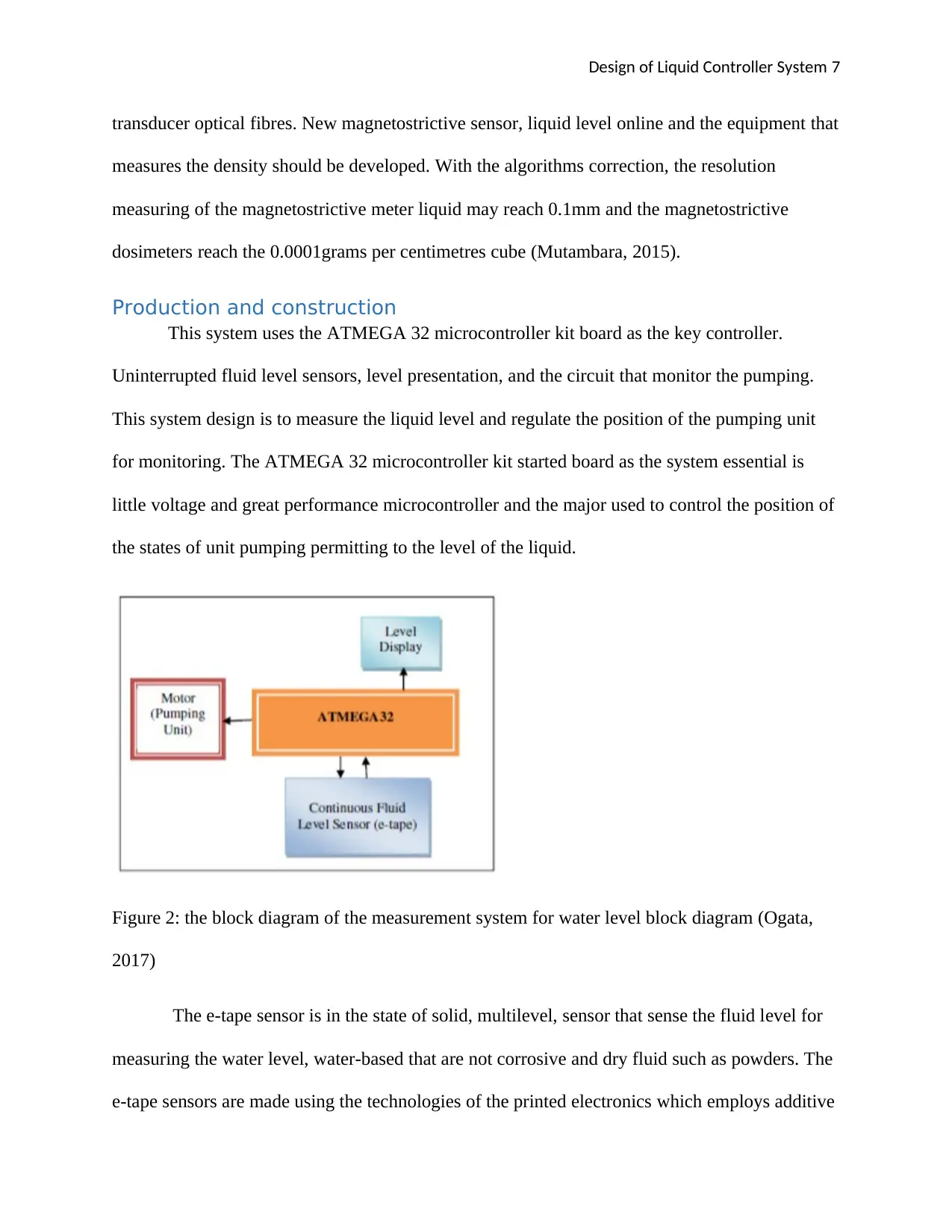
Design of Liquid Controller System 7
transducer optical fibres. New magnetostrictive sensor, liquid level online and the equipment that
measures the density should be developed. With the algorithms correction, the resolution
measuring of the magnetostrictive meter liquid may reach 0.1mm and the magnetostrictive
dosimeters reach the 0.0001grams per centimetres cube (Mutambara, 2015).
Production and construction
This system uses the ATMEGA 32 microcontroller kit board as the key controller.
Uninterrupted fluid level sensors, level presentation, and the circuit that monitor the pumping.
This system design is to measure the liquid level and regulate the position of the pumping unit
for monitoring. The ATMEGA 32 microcontroller kit started board as the system essential is
little voltage and great performance microcontroller and the major used to control the position of
the states of unit pumping permitting to the level of the liquid.
Figure 2: the block diagram of the measurement system for water level block diagram (Ogata,
2017)
The e-tape sensor is in the state of solid, multilevel, sensor that sense the fluid level for
measuring the water level, water-based that are not corrosive and dry fluid such as powders. The
e-tape sensors are made using the technologies of the printed electronics which employs additive
transducer optical fibres. New magnetostrictive sensor, liquid level online and the equipment that
measures the density should be developed. With the algorithms correction, the resolution
measuring of the magnetostrictive meter liquid may reach 0.1mm and the magnetostrictive
dosimeters reach the 0.0001grams per centimetres cube (Mutambara, 2015).
Production and construction
This system uses the ATMEGA 32 microcontroller kit board as the key controller.
Uninterrupted fluid level sensors, level presentation, and the circuit that monitor the pumping.
This system design is to measure the liquid level and regulate the position of the pumping unit
for monitoring. The ATMEGA 32 microcontroller kit started board as the system essential is
little voltage and great performance microcontroller and the major used to control the position of
the states of unit pumping permitting to the level of the liquid.
Figure 2: the block diagram of the measurement system for water level block diagram (Ogata,
2017)
The e-tape sensor is in the state of solid, multilevel, sensor that sense the fluid level for
measuring the water level, water-based that are not corrosive and dry fluid such as powders. The
e-tape sensors are made using the technologies of the printed electronics which employs additive
Paraphrase This Document
Need a fresh take? Get an instant paraphrase of this document with our AI Paraphraser
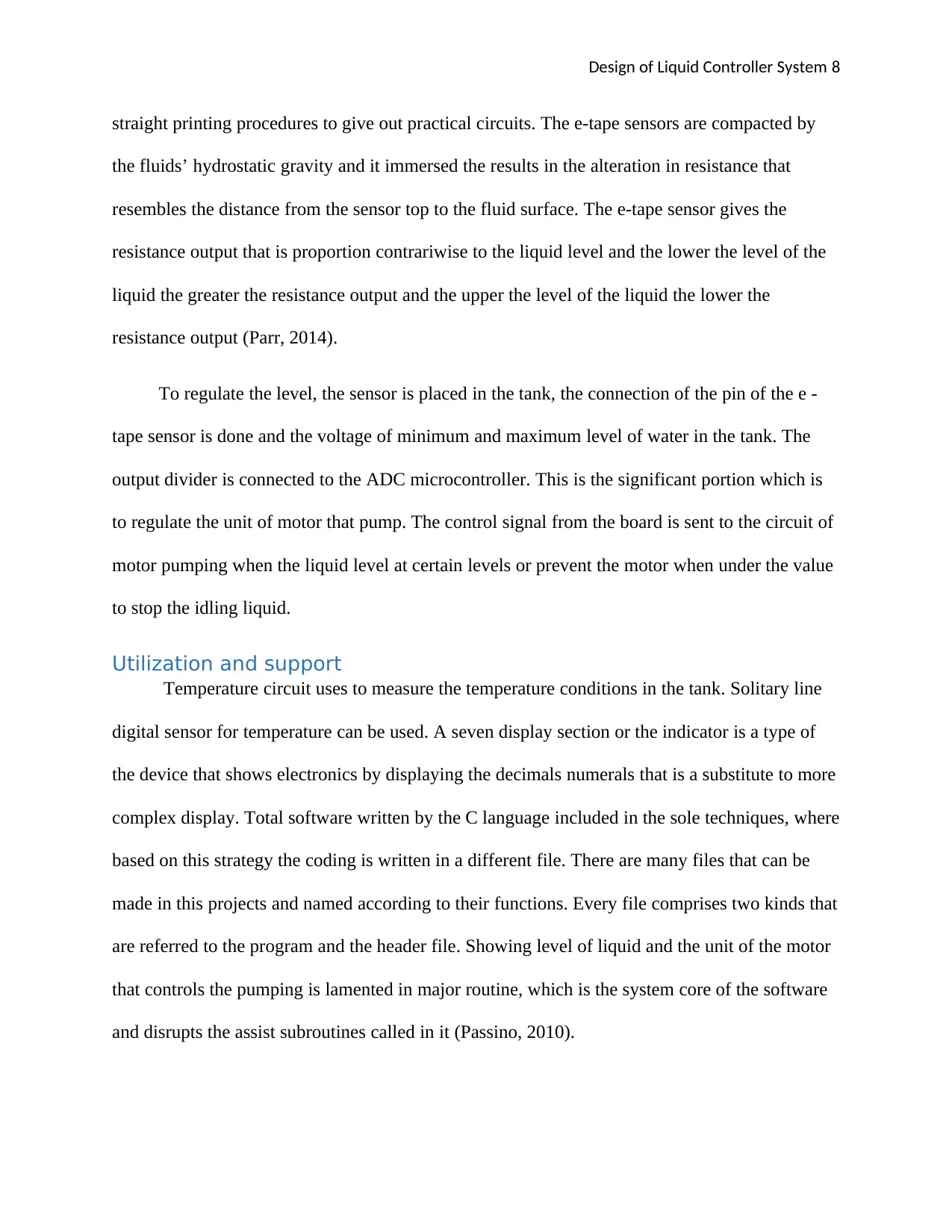
Design of Liquid Controller System 8
straight printing procedures to give out practical circuits. The e-tape sensors are compacted by
the fluids’ hydrostatic gravity and it immersed the results in the alteration in resistance that
resembles the distance from the sensor top to the fluid surface. The e-tape sensor gives the
resistance output that is proportion contrariwise to the liquid level and the lower the level of the
liquid the greater the resistance output and the upper the level of the liquid the lower the
resistance output (Parr, 2014).
To regulate the level, the sensor is placed in the tank, the connection of the pin of the e -
tape sensor is done and the voltage of minimum and maximum level of water in the tank. The
output divider is connected to the ADC microcontroller. This is the significant portion which is
to regulate the unit of motor that pump. The control signal from the board is sent to the circuit of
motor pumping when the liquid level at certain levels or prevent the motor when under the value
to stop the idling liquid.
Utilization and support
Temperature circuit uses to measure the temperature conditions in the tank. Solitary line
digital sensor for temperature can be used. A seven display section or the indicator is a type of
the device that shows electronics by displaying the decimals numerals that is a substitute to more
complex display. Total software written by the C language included in the sole techniques, where
based on this strategy the coding is written in a different file. There are many files that can be
made in this projects and named according to their functions. Every file comprises two kinds that
are referred to the program and the header file. Showing level of liquid and the unit of the motor
that controls the pumping is lamented in major routine, which is the system core of the software
and disrupts the assist subroutines called in it (Passino, 2010).
straight printing procedures to give out practical circuits. The e-tape sensors are compacted by
the fluids’ hydrostatic gravity and it immersed the results in the alteration in resistance that
resembles the distance from the sensor top to the fluid surface. The e-tape sensor gives the
resistance output that is proportion contrariwise to the liquid level and the lower the level of the
liquid the greater the resistance output and the upper the level of the liquid the lower the
resistance output (Parr, 2014).
To regulate the level, the sensor is placed in the tank, the connection of the pin of the e -
tape sensor is done and the voltage of minimum and maximum level of water in the tank. The
output divider is connected to the ADC microcontroller. This is the significant portion which is
to regulate the unit of motor that pump. The control signal from the board is sent to the circuit of
motor pumping when the liquid level at certain levels or prevent the motor when under the value
to stop the idling liquid.
Utilization and support
Temperature circuit uses to measure the temperature conditions in the tank. Solitary line
digital sensor for temperature can be used. A seven display section or the indicator is a type of
the device that shows electronics by displaying the decimals numerals that is a substitute to more
complex display. Total software written by the C language included in the sole techniques, where
based on this strategy the coding is written in a different file. There are many files that can be
made in this projects and named according to their functions. Every file comprises two kinds that
are referred to the program and the header file. Showing level of liquid and the unit of the motor
that controls the pumping is lamented in major routine, which is the system core of the software
and disrupts the assist subroutines called in it (Passino, 2010).
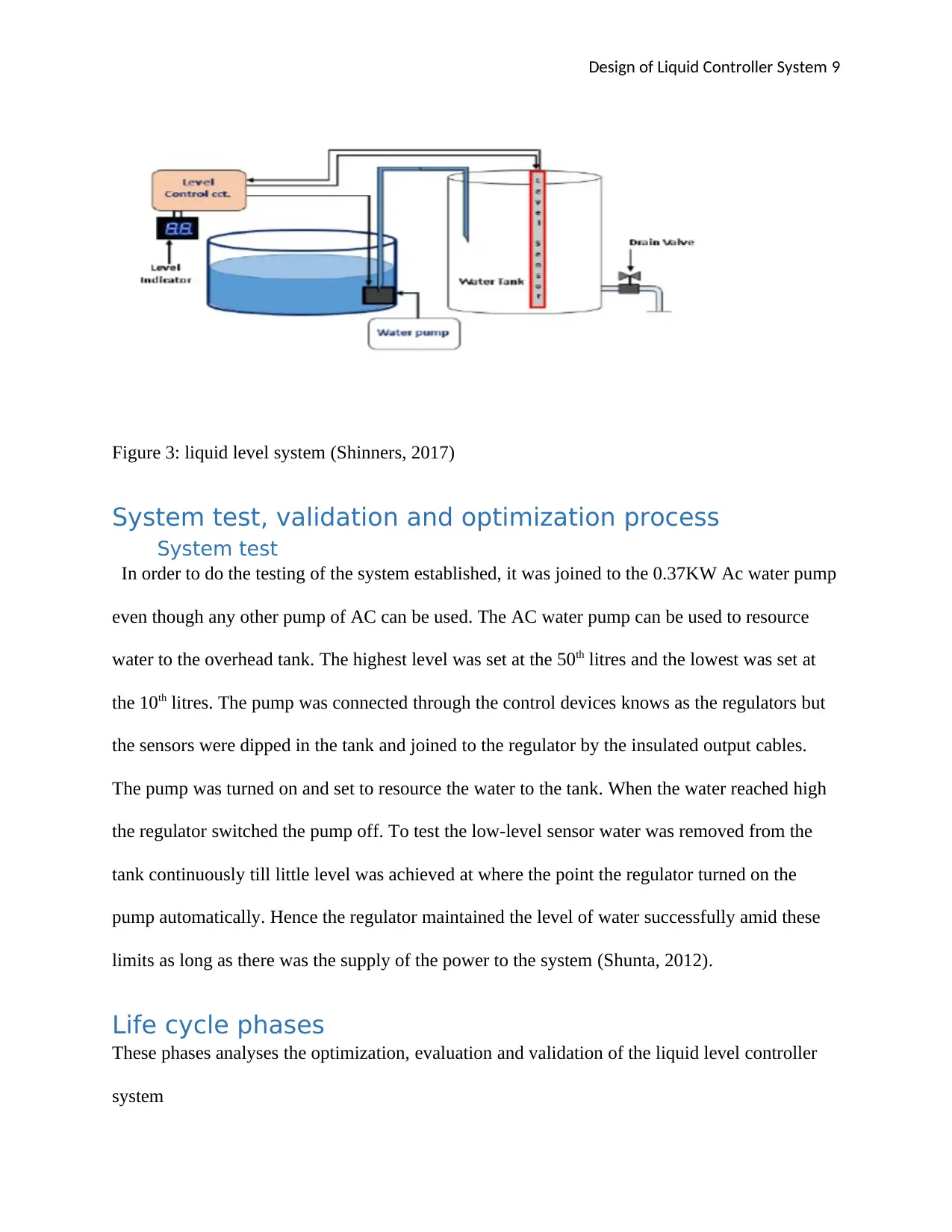
Design of Liquid Controller System 9
Figure 3: liquid level system (Shinners, 2017)
System test, validation and optimization process
System test
In order to do the testing of the system established, it was joined to the 0.37KW Ac water pump
even though any other pump of AC can be used. The AC water pump can be used to resource
water to the overhead tank. The highest level was set at the 50th litres and the lowest was set at
the 10th litres. The pump was connected through the control devices knows as the regulators but
the sensors were dipped in the tank and joined to the regulator by the insulated output cables.
The pump was turned on and set to resource the water to the tank. When the water reached high
the regulator switched the pump off. To test the low-level sensor water was removed from the
tank continuously till little level was achieved at where the point the regulator turned on the
pump automatically. Hence the regulator maintained the level of water successfully amid these
limits as long as there was the supply of the power to the system (Shunta, 2012).
Life cycle phases
These phases analyses the optimization, evaluation and validation of the liquid level controller
system
Figure 3: liquid level system (Shinners, 2017)
System test, validation and optimization process
System test
In order to do the testing of the system established, it was joined to the 0.37KW Ac water pump
even though any other pump of AC can be used. The AC water pump can be used to resource
water to the overhead tank. The highest level was set at the 50th litres and the lowest was set at
the 10th litres. The pump was connected through the control devices knows as the regulators but
the sensors were dipped in the tank and joined to the regulator by the insulated output cables.
The pump was turned on and set to resource the water to the tank. When the water reached high
the regulator switched the pump off. To test the low-level sensor water was removed from the
tank continuously till little level was achieved at where the point the regulator turned on the
pump automatically. Hence the regulator maintained the level of water successfully amid these
limits as long as there was the supply of the power to the system (Shunta, 2012).
Life cycle phases
These phases analyses the optimization, evaluation and validation of the liquid level controller
system
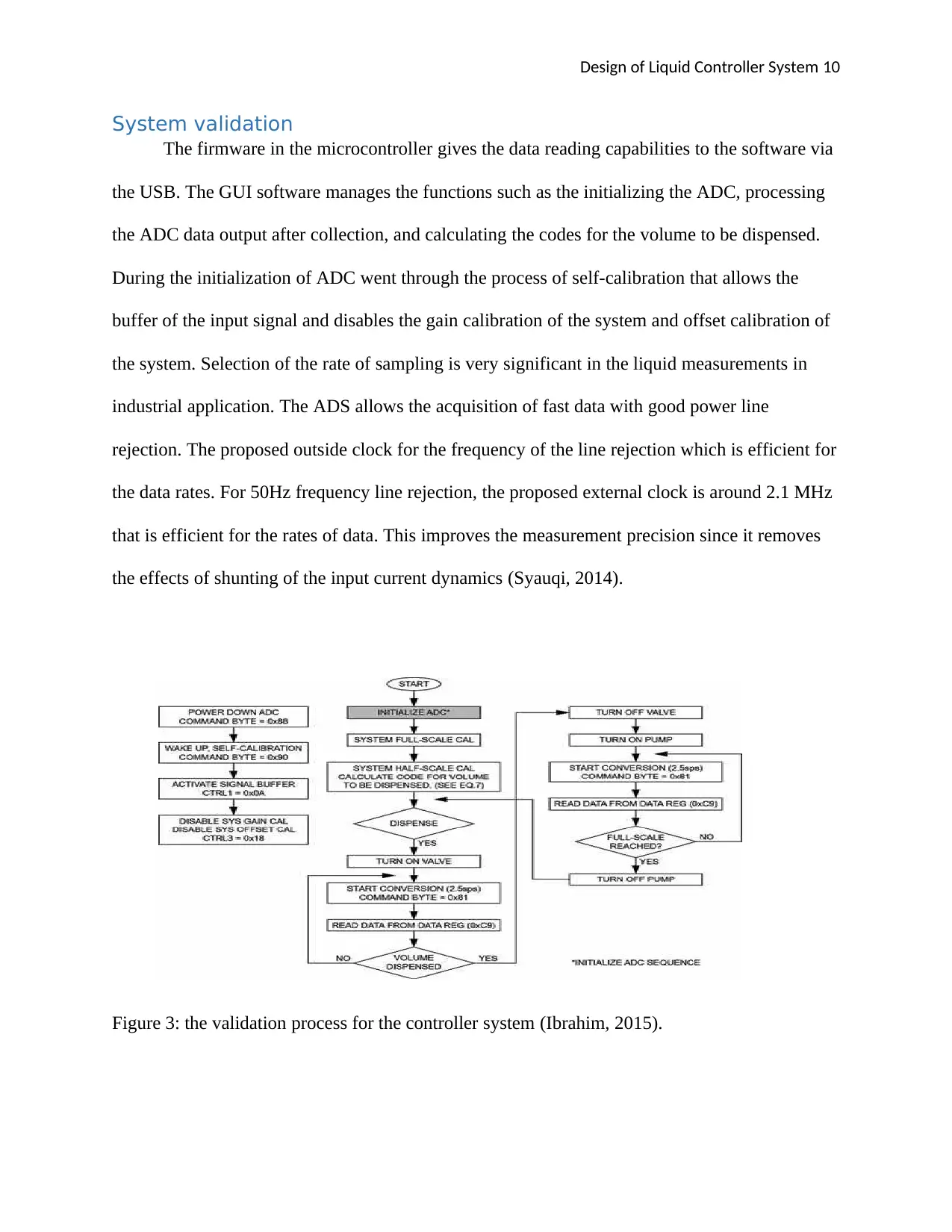
Design of Liquid Controller System 10
System validation
The firmware in the microcontroller gives the data reading capabilities to the software via
the USB. The GUI software manages the functions such as the initializing the ADC, processing
the ADC data output after collection, and calculating the codes for the volume to be dispensed.
During the initialization of ADC went through the process of self-calibration that allows the
buffer of the input signal and disables the gain calibration of the system and offset calibration of
the system. Selection of the rate of sampling is very significant in the liquid measurements in
industrial application. The ADS allows the acquisition of fast data with good power line
rejection. The proposed outside clock for the frequency of the line rejection which is efficient for
the data rates. For 50Hz frequency line rejection, the proposed external clock is around 2.1 MHz
that is efficient for the rates of data. This improves the measurement precision since it removes
the effects of shunting of the input current dynamics (Syauqi, 2014).
Figure 3: the validation process for the controller system (Ibrahim, 2015).
System validation
The firmware in the microcontroller gives the data reading capabilities to the software via
the USB. The GUI software manages the functions such as the initializing the ADC, processing
the ADC data output after collection, and calculating the codes for the volume to be dispensed.
During the initialization of ADC went through the process of self-calibration that allows the
buffer of the input signal and disables the gain calibration of the system and offset calibration of
the system. Selection of the rate of sampling is very significant in the liquid measurements in
industrial application. The ADS allows the acquisition of fast data with good power line
rejection. The proposed outside clock for the frequency of the line rejection which is efficient for
the data rates. For 50Hz frequency line rejection, the proposed external clock is around 2.1 MHz
that is efficient for the rates of data. This improves the measurement precision since it removes
the effects of shunting of the input current dynamics (Syauqi, 2014).
Figure 3: the validation process for the controller system (Ibrahim, 2015).
Secure Best Marks with AI Grader
Need help grading? Try our AI Grader for instant feedback on your assignments.
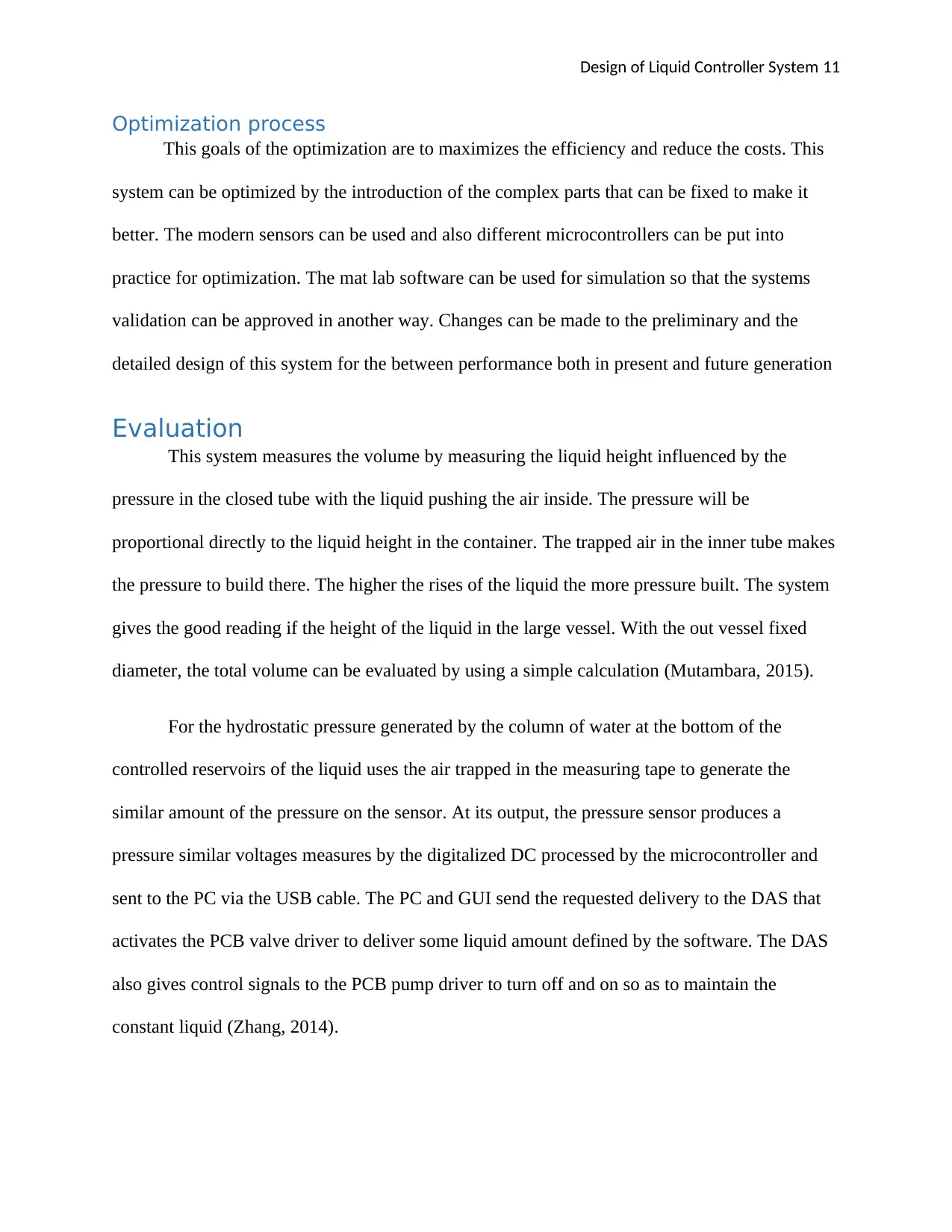
Design of Liquid Controller System 11
Optimization process
This goals of the optimization are to maximizes the efficiency and reduce the costs. This
system can be optimized by the introduction of the complex parts that can be fixed to make it
better. The modern sensors can be used and also different microcontrollers can be put into
practice for optimization. The mat lab software can be used for simulation so that the systems
validation can be approved in another way. Changes can be made to the preliminary and the
detailed design of this system for the between performance both in present and future generation
Evaluation
This system measures the volume by measuring the liquid height influenced by the
pressure in the closed tube with the liquid pushing the air inside. The pressure will be
proportional directly to the liquid height in the container. The trapped air in the inner tube makes
the pressure to build there. The higher the rises of the liquid the more pressure built. The system
gives the good reading if the height of the liquid in the large vessel. With the out vessel fixed
diameter, the total volume can be evaluated by using a simple calculation (Mutambara, 2015).
For the hydrostatic pressure generated by the column of water at the bottom of the
controlled reservoirs of the liquid uses the air trapped in the measuring tape to generate the
similar amount of the pressure on the sensor. At its output, the pressure sensor produces a
pressure similar voltages measures by the digitalized DC processed by the microcontroller and
sent to the PC via the USB cable. The PC and GUI send the requested delivery to the DAS that
activates the PCB valve driver to deliver some liquid amount defined by the software. The DAS
also gives control signals to the PCB pump driver to turn off and on so as to maintain the
constant liquid (Zhang, 2014).
Optimization process
This goals of the optimization are to maximizes the efficiency and reduce the costs. This
system can be optimized by the introduction of the complex parts that can be fixed to make it
better. The modern sensors can be used and also different microcontrollers can be put into
practice for optimization. The mat lab software can be used for simulation so that the systems
validation can be approved in another way. Changes can be made to the preliminary and the
detailed design of this system for the between performance both in present and future generation
Evaluation
This system measures the volume by measuring the liquid height influenced by the
pressure in the closed tube with the liquid pushing the air inside. The pressure will be
proportional directly to the liquid height in the container. The trapped air in the inner tube makes
the pressure to build there. The higher the rises of the liquid the more pressure built. The system
gives the good reading if the height of the liquid in the large vessel. With the out vessel fixed
diameter, the total volume can be evaluated by using a simple calculation (Mutambara, 2015).
For the hydrostatic pressure generated by the column of water at the bottom of the
controlled reservoirs of the liquid uses the air trapped in the measuring tape to generate the
similar amount of the pressure on the sensor. At its output, the pressure sensor produces a
pressure similar voltages measures by the digitalized DC processed by the microcontroller and
sent to the PC via the USB cable. The PC and GUI send the requested delivery to the DAS that
activates the PCB valve driver to deliver some liquid amount defined by the software. The DAS
also gives control signals to the PCB pump driver to turn off and on so as to maintain the
constant liquid (Zhang, 2014).
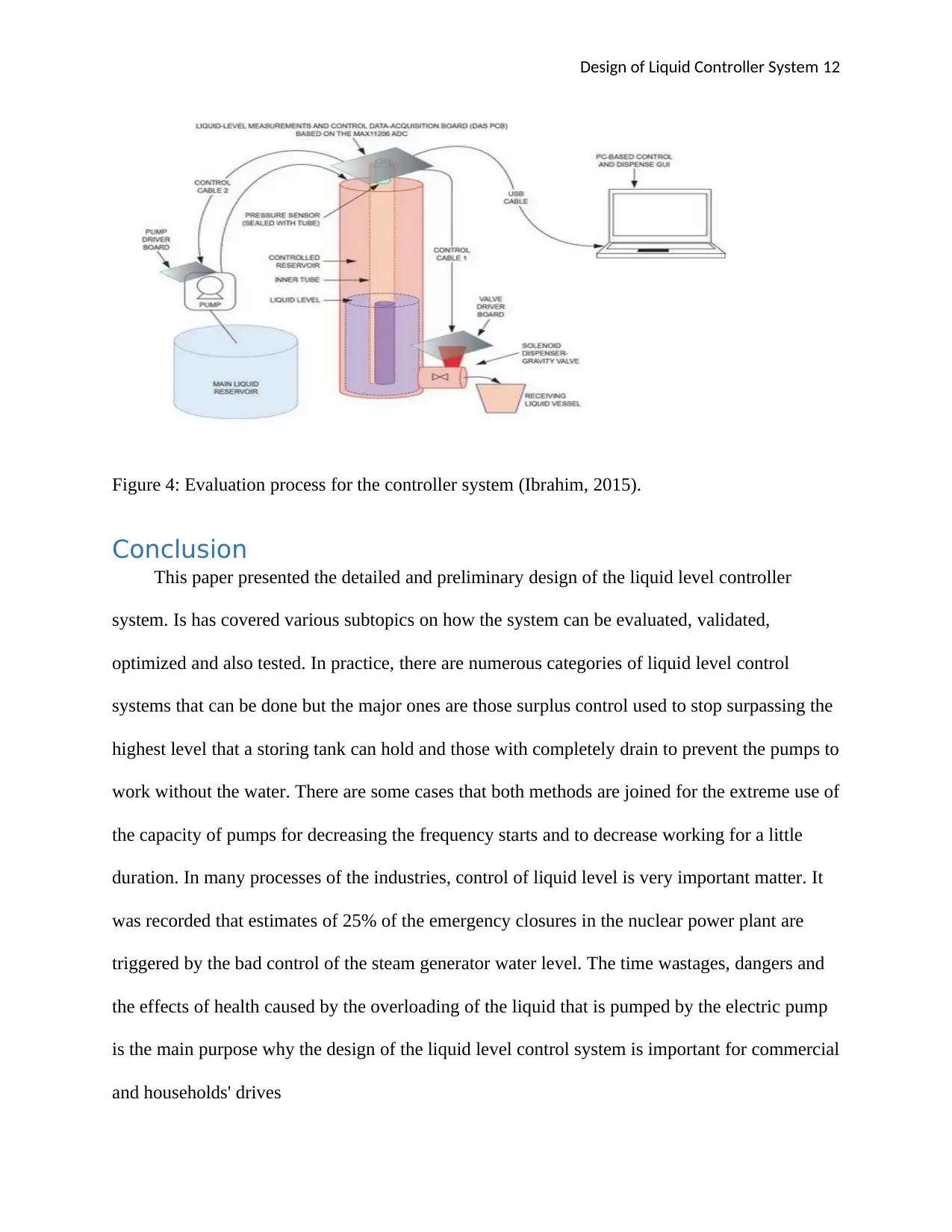
Design of Liquid Controller System 12
Figure 4: Evaluation process for the controller system (Ibrahim, 2015).
Conclusion
This paper presented the detailed and preliminary design of the liquid level controller
system. Is has covered various subtopics on how the system can be evaluated, validated,
optimized and also tested. In practice, there are numerous categories of liquid level control
systems that can be done but the major ones are those surplus control used to stop surpassing the
highest level that a storing tank can hold and those with completely drain to prevent the pumps to
work without the water. There are some cases that both methods are joined for the extreme use of
the capacity of pumps for decreasing the frequency starts and to decrease working for a little
duration. In many processes of the industries, control of liquid level is very important matter. It
was recorded that estimates of 25% of the emergency closures in the nuclear power plant are
triggered by the bad control of the steam generator water level. The time wastages, dangers and
the effects of health caused by the overloading of the liquid that is pumped by the electric pump
is the main purpose why the design of the liquid level control system is important for commercial
and households' drives
Figure 4: Evaluation process for the controller system (Ibrahim, 2015).
Conclusion
This paper presented the detailed and preliminary design of the liquid level controller
system. Is has covered various subtopics on how the system can be evaluated, validated,
optimized and also tested. In practice, there are numerous categories of liquid level control
systems that can be done but the major ones are those surplus control used to stop surpassing the
highest level that a storing tank can hold and those with completely drain to prevent the pumps to
work without the water. There are some cases that both methods are joined for the extreme use of
the capacity of pumps for decreasing the frequency starts and to decrease working for a little
duration. In many processes of the industries, control of liquid level is very important matter. It
was recorded that estimates of 25% of the emergency closures in the nuclear power plant are
triggered by the bad control of the steam generator water level. The time wastages, dangers and
the effects of health caused by the overloading of the liquid that is pumped by the electric pump
is the main purpose why the design of the liquid level control system is important for commercial
and households' drives
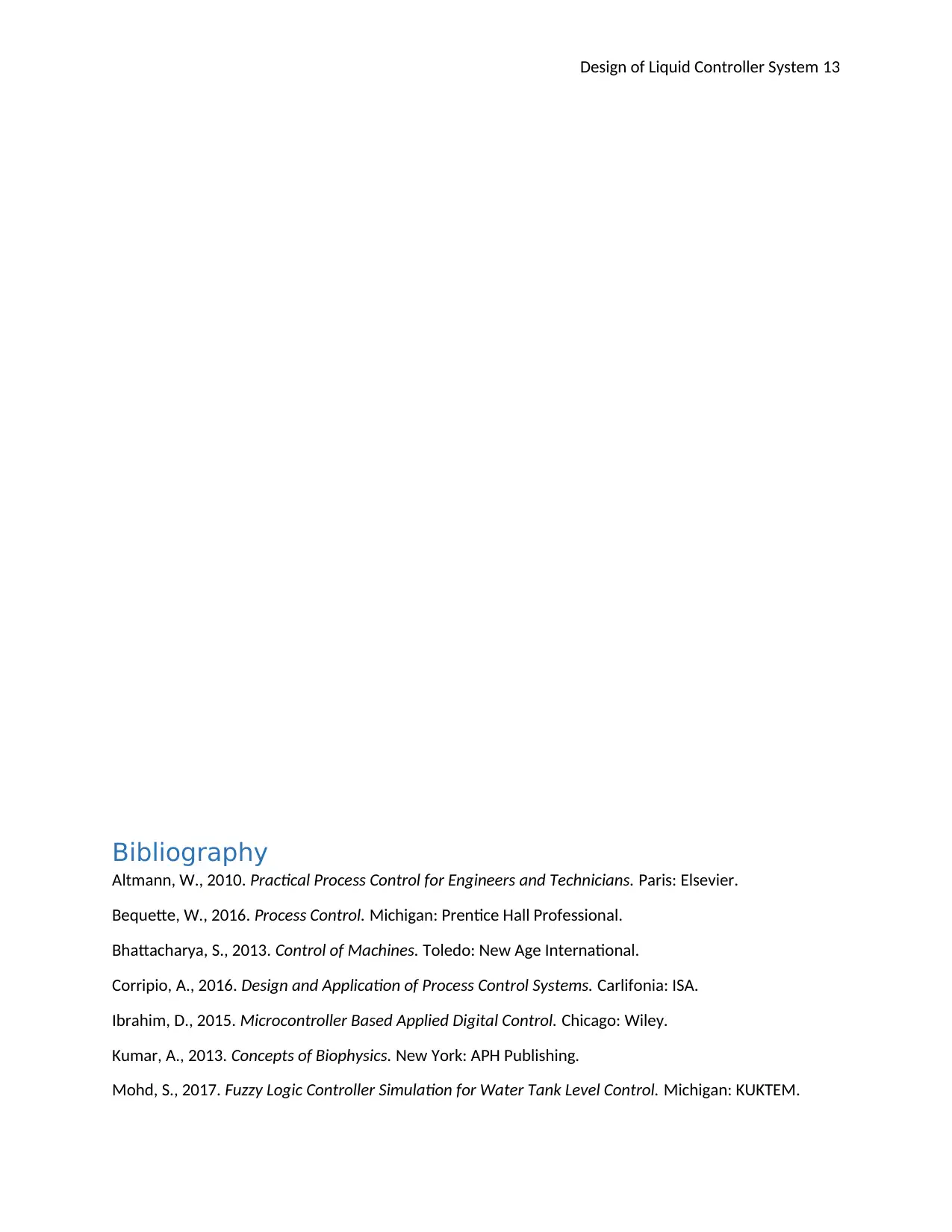
Design of Liquid Controller System 13
Bibliography
Altmann, W., 2010. Practical Process Control for Engineers and Technicians. Paris: Elsevier.
Bequette, W., 2016. Process Control. Michigan: Prentice Hall Professional.
Bhattacharya, S., 2013. Control of Machines. Toledo: New Age International.
Corripio, A., 2016. Design and Application of Process Control Systems. Carlifonia: ISA.
Ibrahim, D., 2015. Microcontroller Based Applied Digital Control. Chicago: Wiley.
Kumar, A., 2013. Concepts of Biophysics. New York: APH Publishing.
Mohd, S., 2017. Fuzzy Logic Controller Simulation for Water Tank Level Control. Michigan: KUKTEM.
Bibliography
Altmann, W., 2010. Practical Process Control for Engineers and Technicians. Paris: Elsevier.
Bequette, W., 2016. Process Control. Michigan: Prentice Hall Professional.
Bhattacharya, S., 2013. Control of Machines. Toledo: New Age International.
Corripio, A., 2016. Design and Application of Process Control Systems. Carlifonia: ISA.
Ibrahim, D., 2015. Microcontroller Based Applied Digital Control. Chicago: Wiley.
Kumar, A., 2013. Concepts of Biophysics. New York: APH Publishing.
Mohd, S., 2017. Fuzzy Logic Controller Simulation for Water Tank Level Control. Michigan: KUKTEM.
Paraphrase This Document
Need a fresh take? Get an instant paraphrase of this document with our AI Paraphraser
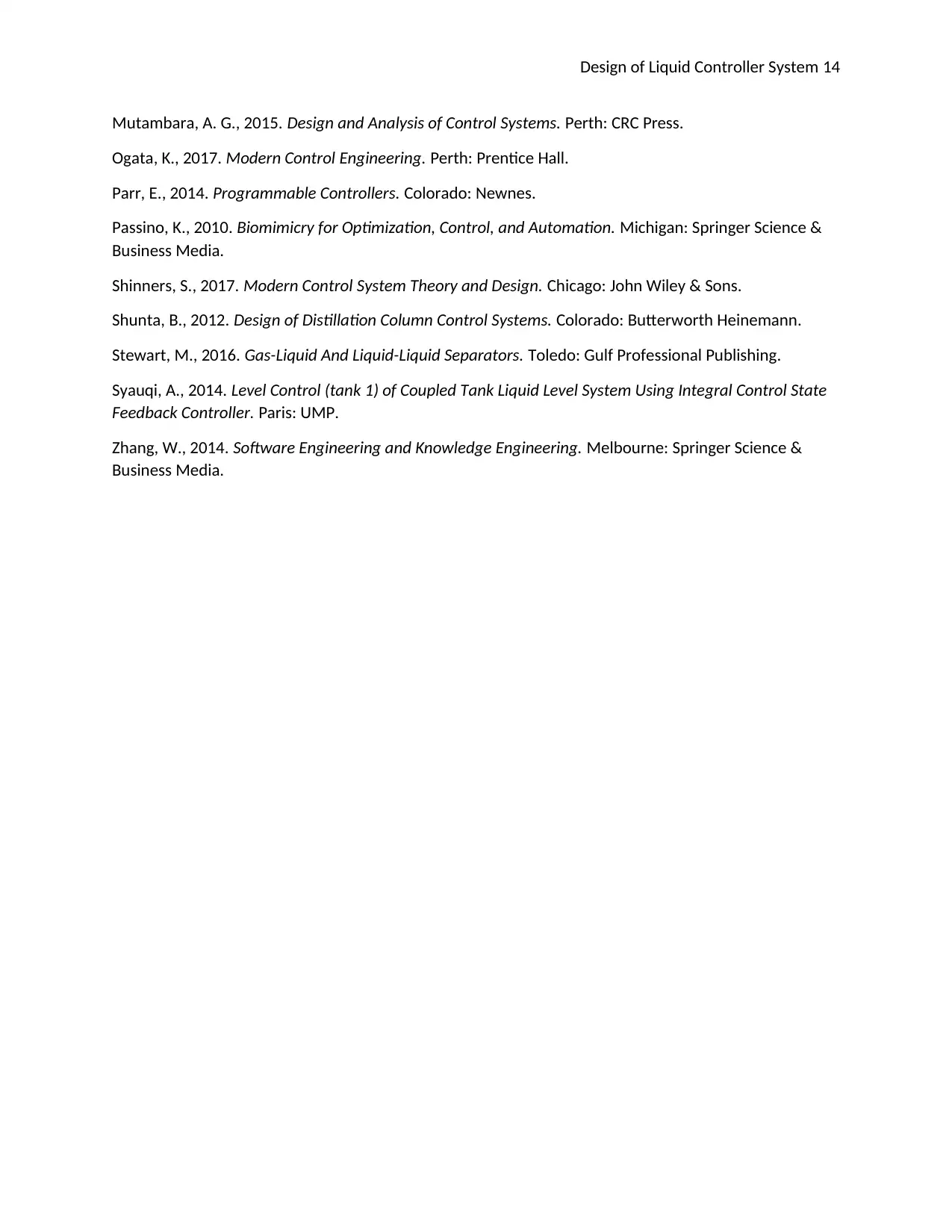
Design of Liquid Controller System 14
Mutambara, A. G., 2015. Design and Analysis of Control Systems. Perth: CRC Press.
Ogata, K., 2017. Modern Control Engineering. Perth: Prentice Hall.
Parr, E., 2014. Programmable Controllers. Colorado: Newnes.
Passino, K., 2010. Biomimicry for Optimization, Control, and Automation. Michigan: Springer Science &
Business Media.
Shinners, S., 2017. Modern Control System Theory and Design. Chicago: John Wiley & Sons.
Shunta, B., 2012. Design of Distillation Column Control Systems. Colorado: Butterworth Heinemann.
Stewart, M., 2016. Gas-Liquid And Liquid-Liquid Separators. Toledo: Gulf Professional Publishing.
Syauqi, A., 2014. Level Control (tank 1) of Coupled Tank Liquid Level System Using Integral Control State
Feedback Controller. Paris: UMP.
Zhang, W., 2014. Software Engineering and Knowledge Engineering. Melbourne: Springer Science &
Business Media.
Mutambara, A. G., 2015. Design and Analysis of Control Systems. Perth: CRC Press.
Ogata, K., 2017. Modern Control Engineering. Perth: Prentice Hall.
Parr, E., 2014. Programmable Controllers. Colorado: Newnes.
Passino, K., 2010. Biomimicry for Optimization, Control, and Automation. Michigan: Springer Science &
Business Media.
Shinners, S., 2017. Modern Control System Theory and Design. Chicago: John Wiley & Sons.
Shunta, B., 2012. Design of Distillation Column Control Systems. Colorado: Butterworth Heinemann.
Stewart, M., 2016. Gas-Liquid And Liquid-Liquid Separators. Toledo: Gulf Professional Publishing.
Syauqi, A., 2014. Level Control (tank 1) of Coupled Tank Liquid Level System Using Integral Control State
Feedback Controller. Paris: UMP.
Zhang, W., 2014. Software Engineering and Knowledge Engineering. Melbourne: Springer Science &
Business Media.
1 out of 14
Related Documents
Your All-in-One AI-Powered Toolkit for Academic Success.
+13062052269
info@desklib.com
Available 24*7 on WhatsApp / Email
![[object Object]](/_next/static/media/star-bottom.7253800d.svg)
Unlock your academic potential
© 2024 | Zucol Services PVT LTD | All rights reserved.




